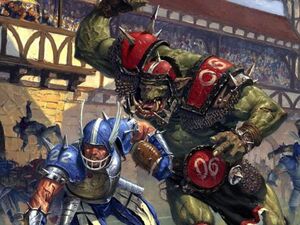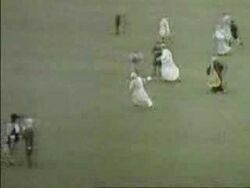UnNews:Despite lockout, fantasy football a go
| The news outlet with approval higher than Congress | ✪ | UnNews | ✪ | Wednesday, January 7, 2026, 23:26:59 (UTC) |
| Despite lockout, fantasy football a go | 
|
24 April 2011
SAN DIEGO, California -- The NFL season might be in doubt, but Fantasy Football is all set. At least, that's what Comic-Con International claims. While NFL owners and players have grappled with each other over how many millions they'll make in the coming years, the organization behind the San Diego Comic Convention have been working day and night to fill in the potential gap for millions of Americans. Since rumors of the potential lockout began swirling late last season, the non-profit group began quietly hiring retired coaches and football experts, as well as writers and CGI experts, to conceive, script, and execute a full length "Fantasy Football" season from scratch.
"We'd heard that, if the football season didn't happen, the nation's economy could lose as much as $3.5 billion," Clark Thomas, Comic Con's public relations consultant, mentioned, "So we decided that, not only was this a great way to publicize our group, it would help out the country's economy and even give husbands all over America an excuse not to go to church." Undeterred by the immense size of their project, Comic Con began picking up football experts, from retired coaches like Dennis Green and Jim Mora to analysts like Mike Greenberg, on temporary contracts to forecast the 2011 season and put up statistics in real time, as if the season were actually being played.
"The idea was to have everything happen as it usually does, except that there would be no television or other media coverage of the games," Jerry Gerould, the man behind the Fantasy Football 2011 project, said, "It would be like NFL 2011 was still a go, but all the games were being blacked out. We even had television spots lined up to provide 'post-game' analysis of our made up games."
Things took a turn for the worse, however, when the NFL Player's Association (NFLPA) told Comic Con that there would be a lawsuit if they used the names of actual players, which sent the project managers back to the drawing board.
"Without the NFLPA's consent to use the names, not only would there be no games to watch, there wouldn't even be any names to follow." Gerould lamented, "We'd done all of that work and spent all of that money on the project - we even had TV time in our name - and all for nothing. We thought we were screwed."
Thinking that they were finished and that the project would be marked off as a horrible and expensive failure, the team was dismal. But inspiration and the resolve to continue comes from strange places; in this case, a YouTube video of an old Monty Python sketch.
"Paul always used to watch Monty Python when he was bummed, so after the news from the NFLPA he just disappeared in his office for awhile," Gerould recalls, "All of a sudden, he burst out and ran around the office shouting 'Eureka' before hitting us with his great idea."
The idea was a small one, but would require nothing short of a miracle to pull off: They didn't need to have real football players for their project. Why couldn't they use fictional characters from, say, fantasy books? They could even make CGI renditions of them, plug the models into a kind of football video game, and then broadcast the game on TV.
"Mind blown," Gerould said, using his hands to imitate the event.
Quickly adding fantasy readers to the payroll to help turn literary characters into football players, Comic Con International sent requests to established authors, requesting the use of their creations to tackle and score against the creations of their peers.

"The fantasy community was astoundingly helpful," Clark Thomas said, "We could never have pulled it off without them."
The group then furiously brainstormed and began assigning characters to positions, and then to teams. After settling the easier decisions, such as putting Grendal at nose-tackle for the Oakland Raiders, Voldemort at middle linebacker for the Chicago Bears (to replace lookalike Brian Urlacher), and making Boromir the Vikings' halfback, things started getting a little testy.
"I still think Gandalf should be a receiver," writer Oliver Proctor pouted, "Hello! Shadowfax?"
"Gandalf would obviously be at safety," Damien Simpson countered, "Only a fool like Oliver would put him at split end."
Compromises were made, and the players were then given attributes and inserted into a custom roster for Madden 2011, which was then simulated through several seasons to approximate the results. After every season's data was produced, the experts would analyze the statistics to point out any anomalies in them, most often caused by such factors as the computer's erroneous playcalling strategy in certain situations, or the unwillingness of referees to throw a flag on every last punt return. After nearly 50 trial seasons, the player attributes had been ironed out, the playbooks honed, and the strategies developed for each one of the NFL's 32 teams.
While the football experts were fine tuning their end of the project, the CGI modelers were making replicas of the characters, which wasn't as easy as it sounded.
"The designers for Madden had it easy," John Little said. "All of their players are from the same race. But Treebeard and Aslan require completely different models, so that's more work for us."
Nevertheless, everything is coming out smoothly, and project manager Gerould reports that they're just finishing up the regular season, and should have the playoffs done by August.
"Even if the lockout does happen, football will happen," Gerould boasts. "Just be ready to hear Martin the Warrior drops to pass... looks for tight end Gimli in the flat, but he's covered by the Black Knight and, OH he's been sacked by Titans' defensive tackle Atlas who shrugged past Goliath with a swim move - his third sack of the season - to bring up fourth down and punter Bilbo Baggins."
Sources[edit]
| This article features first-hand journalism by an UnNews correspondent. |

